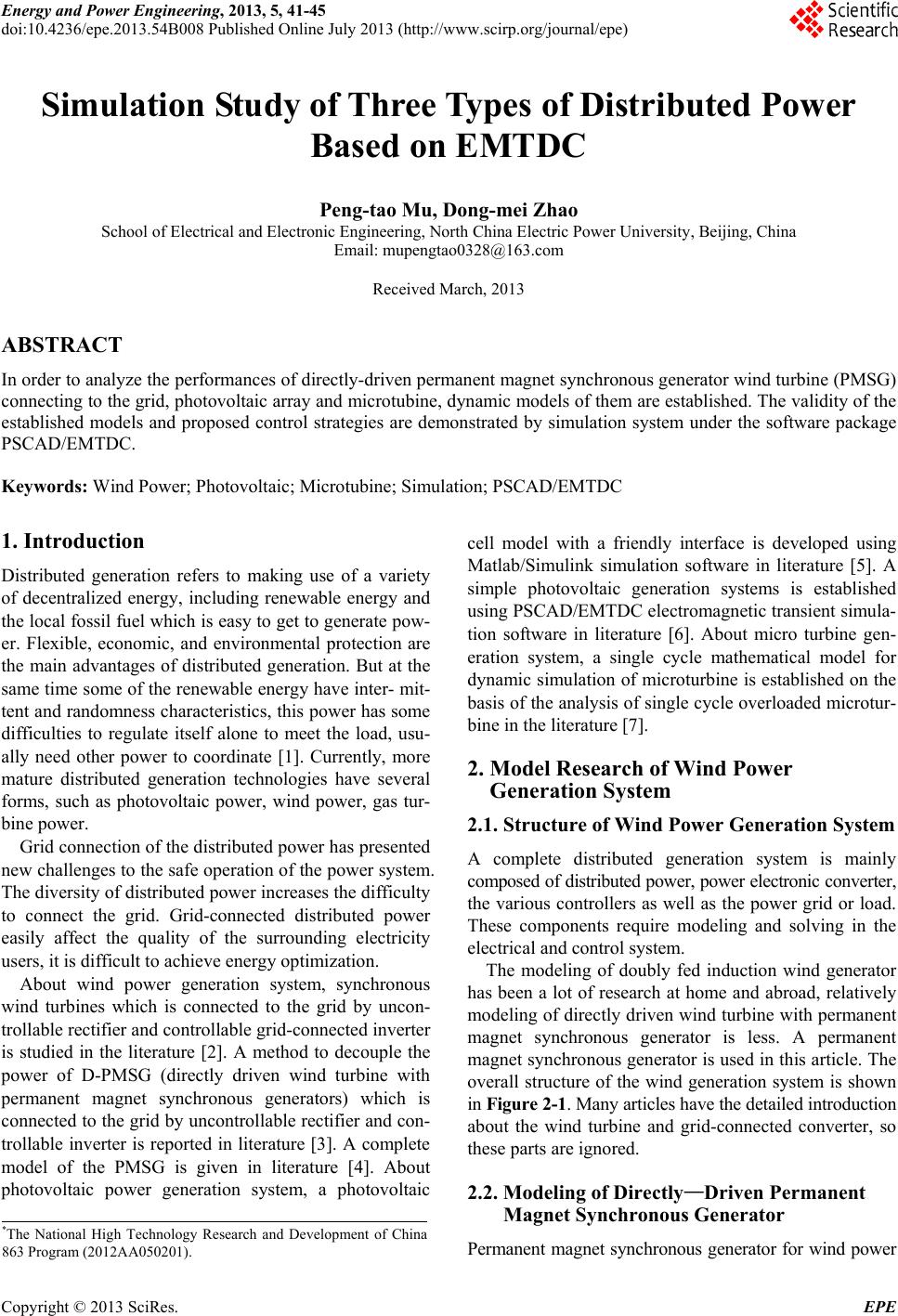
Energy and Power Engineering, 2013, 5, 41-45
doi:10.4236/epe.2013.54B008 Published Online July 2013 (http://www.scirp.org/journal/epe)
Simulation Study of Three Types of Distributed Power
Based on EMTDC
Peng-tao Mu, Dong-mei Zhao
School of Electrical and Electronic Engineering, North China Electric Power University, Beijing, China
Email: mupengtao0328@163.com
Received March, 2013
ABSTRACT
In order to analyze the performances of directly-driven permanent magnet synchronous generator wind turbine (PMSG)
connecting to the grid, photovoltaic array and microtubine, dynamic models of them are established. The validity of the
established models and proposed control strategies are demonstrated by simulation system under the software package
PSCAD/EMTDC.
Keywords: Wind Power; Photovoltaic; Microtubine; Simulation; PSCAD/EMTDC
1. Introduction
Distributed generation refers to making use of a variety
of decentralized energy, including renewable energy and
the local fossil fuel which is easy to g et to generate pow-
er. Flexible, economic, and environmental protection are
the main advantages of distributed generation. But at the
same time some of the renewable energy have inter- mit-
tent and randomness characteristics, this power has some
difficulties to regulate itself alone to meet the load, usu-
ally need other power to coordinate [1]. Currently, more
mature distributed generation technologies have several
forms, such as photovoltaic power, wind power, gas tur-
bine power.
Grid connection of the distributed power has presented
new challenges to the safe operation of the power system.
The diversity of distr ibu ted pow er increases the difficulty
to connect the grid. Grid-connected distributed power
easily affect the quality of the surrounding electricity
users, it is difficult to achieve energy optimizatio n.
About wind power generation system, synchronous
wind turbines which is connected to the grid by uncon-
trollable rectifier and controllable grid-connected inverter
is studied in the literature [2]. A method to decouple the
power of D-PMSG (directly driven wind turbine with
permanent magnet synchronous generators) which is
connected to the grid by uncontrollable rectifier and con-
trollable inverter is reported in literature [3]. A complete
model of the PMSG is given in literature [4]. About
photovoltaic power generation system, a photovoltaic
cell model with a friendly interface is developed using
Matlab/Simulink simulation software in literature [5]. A
simple photovoltaic generation systems is established
using PSCAD/EMTDC electromagnetic transient simula-
tion software in literature [6]. About micro turbine gen-
eration system, a single cycle mathematical model for
dynamic simulation of microturbine is established on the
basis of the analysis of single cycle overloaded microtur-
bine in the literature [7].
2. Model Research of Wind Power
Generation System
2.1. Structure of Wind Power Generation System
A complete distributed generation system is mainly
composed of distributed power, power electronic conv erter,
the various controllers as well as the power grid or load.
These components require modeling and solving in the
electrical and control system.
The modeling of doubly fed induction wind generator
has been a lot of research at home and abroad, relatively
modeling of directly driven wind turbine with permanent
magnet synchronous generator is less. A permanent
magnet synchronous generator is used in this article. The
overall structure of the wind generation system is shown
in Figure 2-1. Many articles have the detailed introduction
about the wind turbine and grid-connected converter, so
these parts are ignored.
2.2. Modeling of Directly—Driven Permanent
Magnet Synchronous Generator
*The National High Technology Research and Development of China
863 Program (2012AA050201). Permanent magnet synchronous generator for wind power
Copyright © 2013 SciRes. EPE